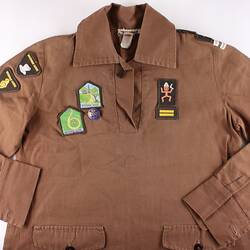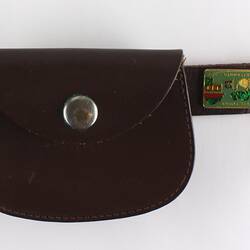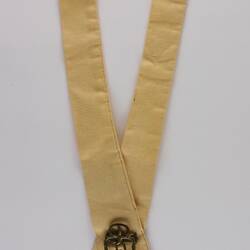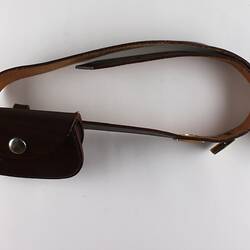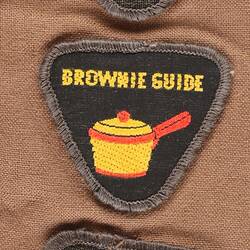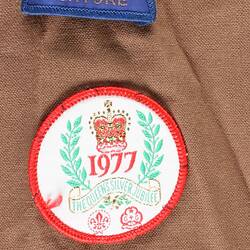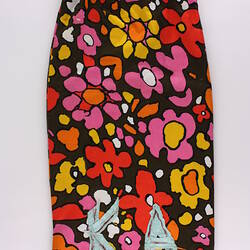Summary
Brownie uniform comprising dress, tie and belt with pouch. Worn by Kathryn Anderson when a brownie, during and around 1977. She was part of the 1st Heatherdale pack, in outer eastern Melbourne, from 1977 to around 1979.
The dress is decorated with several cloth patches, representing particular skills, knowledge and experiences gained. The wearer obtained: Hostess (cup and saucer symbol); House Orderly (broom); Jester (jester's head); Writer (pen and scroll); Thrift (bee); Cook (saucepan); and Artist (pencil). She also obtained two Brownie Journeys badges, for Footpath and Road; and a Venture badge for taking part in a 'pack' outing. Two yellow stars on black symbolize the two years since the wearer made her 'Promise'.
The little pink dancing figure with a boomerang and pointed hat indicates that she is one of the Junjarins - 'good spirits and the hardest working spirits in the bush. They make sure that the sick and helpless creatures have food, water and shelter. Their favourite job is to watch over the trees and flowers in the bush. They love helping the wildflowers to open their petals and baby ferns to uncurl their tight little fronds. Their grins are so bright and cheerful, they are often taken for the rising sun.' (Australian Brownie Guide Book, 1975). The two yellow stripes on green indicate that she is a 'Sixer' - ie. the leader of her pack.
Physical Description
Brownie uniform comprising dress, tie and belt with pouch. Dress is mid-brown (somewhat faded), with long sleeves, slightly A-line with short front opening at top. Collar is square-cornered with single button hidden underneath. Cuffs also have single button on each. Pocket with flap and button on each hip. Many cloth badges have been sewn onto dress: seven on right arm, five on left arm and four on chest. At the back of the collar is white cloth name badge inscribed in red 'Kathryn Anderson'. Makers' labels appear below. Attached to upper right chest is a brass (or similar) badge with blue enamel infill - a symbol with three-leafed clover. The tie is pale yellow, and comprises two pieces of fabric held together near one end with a small 21 x 21mm brass badge showing a figure within a clover - the Brownie symbol. The other ends of the tie are fastened at the back of the neck with two buttons. A white cloth name badge has been sewn on the back of the tie - inscribed in red 'Kathryn Anderson'. The belt is brown leather, threaded with a semi-circular pouch fastened with a silver press stud. Two gold-coloured (brass?) enamelled badges have been attached to the belt, each one inscribed 'VICTORIA/ BRITANNIA PARK' and featuring a small coloured image of trees and a building. Inscribed on back of belt and inside pouch in texta: '"Kathryn Anderson". 1st Heatherdale.'
Significance
Material relating to the history of the Brownies in Australia documents an organisation that was an important part of the mid-childhood years for many Australian girls during most of the 20th century. No longer in existence, the Brownies provided educational, moral, social and cultural guidance to its members, and its material culture therefore offers significant information about the experiences and perceptions of girls at the time. As a long-standing organisation with continuity of tradition, some of its values and approaches may be seen as archaic - casting an interesting light upon the organisation in its later years and well as illuminating earlier attitudes. Provenanced material - such as this collection - is even more significant since it documents individual experience.
Brownies were girls aged around seven to ten years old. They belonged to a unit that was part of the larger body of Guiding organisations that originated in England in 1907, led by military hero Robert Baden-Powell.
In Victoria, the Florence Nightingale Girl Aids were established in 1909; two years later they were recognised as Baden-Powell Girl Guides. It was not until 1914, though, that Baden-Powell established the Brownies for younger girls, completing the range of age groups both for girls and boys in the Scouting movement. The Brownies were run first by his sister, then his wife. In Australia, the Guiding movement, including the Brownies, was formalized into a national body in the 1920s.
In 1996, the Brownie Guide Unit in Australia was absorbed into the Girl Guides. The values of the Brownies, however, remain the same today within the Girl Guides.
More Information
-
Collecting Areas
-
Acquisition Information
Donation from Kate Anderson, 12 Aug 2010
-
Place & Date Made
-
Inscriptions
Cloth labels include '1977 / THE QUEEN'S SILVER JUBILEE', 'BROWNIE GUIDE' (six, each with a different symbol) and 'VENTURE'. The left arm also includes cloth names simply inscribed 'HEATHERDALE' and 'MAROONDAH REGION'. Maker's labels at collar: 'LS' and 'DRIP DRY FINISH / DO NOT BOIL / OR USE BLEACH / A LITTLE IRONING / MAY BE NECESSARY / HANG IN SHADE'. At the back of the collar is white cloth name badge inscribed in red 'Kathryn Anderson'. A white cloth name badge has been sewn on the back of the tie - inscribed in red 'Kathryn Anderson'. Inscribed on back of belt and inside pouch in texta: '"Kathryn Anderson". 1st Heatherdale.' Badges on belt are inscribed 'VICTORIA/ BRITANNIA PARK'.
-
Classification
-
Category
-
Discipline
-
Type of item
-
References
Girl Guides Australia web site [Link 1] accessed 1/7/2011 'Brownie (Girl Guides)' - Wikipedia [Link 2](Girl_Guides), accessed 1/7/2011
-
Keywords
Children, Children's Uniforms, Girl Guides & Brownies, Guides Movement

